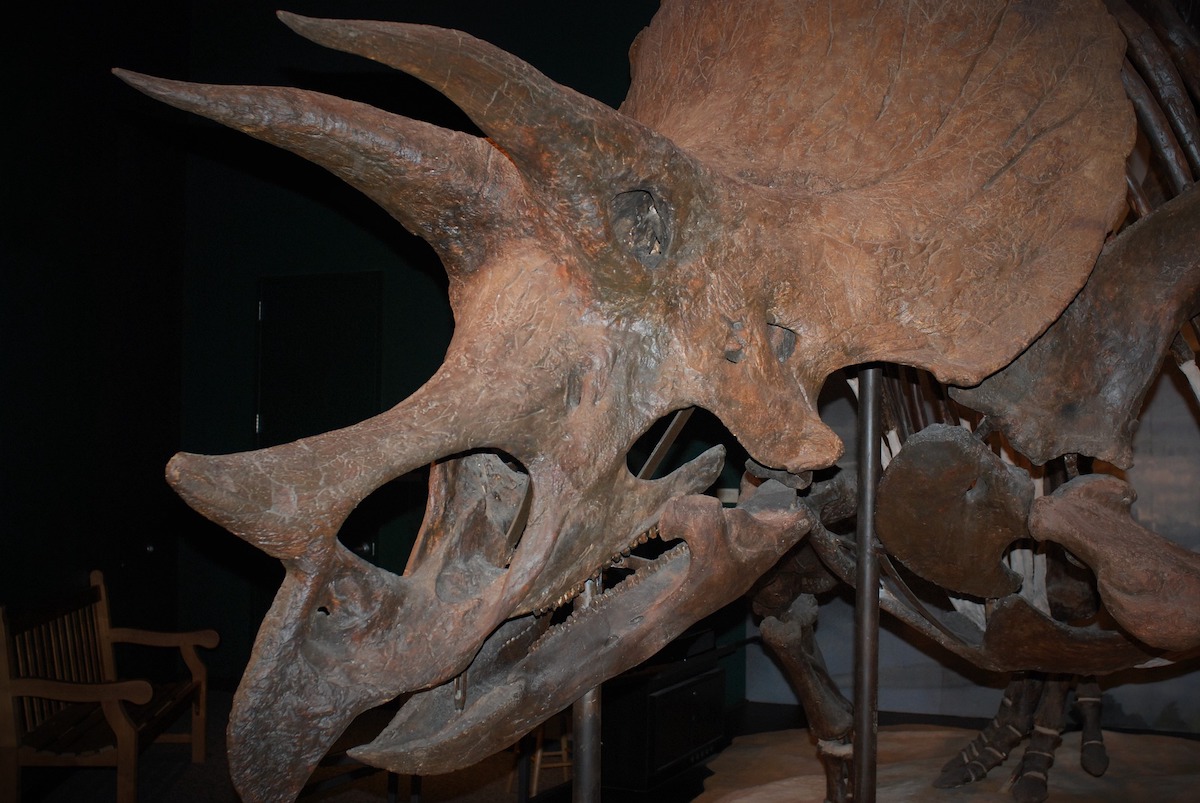 Microbiology
Microbiology
Long-dead dinosaurs support new life
Some researchers think that fossilized dinosaur bones can preserve ancient proteins and other soft tissues. Our recent work using a variety of methods failed to detect evidence for ancient protein but did discover a unique microbial community living within buried fossils.

Modern scientific equipment has revolutionized the study of hidden life. Advances in genetic sequencing allow us to discover mysterious worlds of diverse microbes in Earth's harshest environments or within our bodies.
Life also hides from us through time. Studying long-extinct creatures can be challenging. We must separate speculations from evidence-based assertions. Modern chemical analyses have opened new lines of evidence and research. Protein and DNA sequences can resolve evolutionary relationships, and detecting fossil pigments even allows us to reconstruct dinosaur colors.
Some organic molecules break down faster than others. DNA is the least stable, the oldest coming from 750,000-year-old bones in permafrost. However, fossil steroids can persist for hundreds-of-millions of years. Some have suggested that certain biological structures and molecules thought to degrade quickly can preserve in dinosaur fossils over 66 million years old, including collagen protein and blood vessels in the bone.
Although these reports garnered much scientific and popular interest, other scientists were skeptical of such seemingly miraculous preservation. Some suggested that the results were statistically insignificant or possibly laboratory contamination. Others, like myself, are also concerned about environmental contamination.
This alternative explanation is that some of the starting material of these studies was a biofilm, a structure produced by a bacterial colony and its secretions, forming within cavities of the bone mineral. Accordingly, we tested whether the organic material inside the dinosaur bone was ancient and whether it was deriving from within the bone itself.
To do this, I had to excavate fresh fossil bone. I went to Dinosaur Provincial Park in Canada to a dense bone bed of the horned Centrosaurus. After removing overlying sediment, I used sterilized equipment to collect the fossils and surrounding sediment as aseptically as possible to limit any alteration of the specimens. Dig techniques have changed little in the last century, and we still cannot collect environmental samples in the sorts of highly sterile conditions of the lab. The bones were kept refrigerated as much as possible until they could be analyzed in several different labs.
Our team then applied a battery of chemical analyses. We found recent organic material in the bone at elevated concentrations compared to the surrounding sediment, consistent with a modern microbial community, but found no evidence for ancient dinosaur protein.
When we dissolved the mineral component of the bone in acid, the resulting exposed structures had some mineralization typical of a biofilm. They lacked the elemental composition of collagen seen in the modern or thousands-of-year-old bone under X-ray spectroscopy, and some vessels showed infilling. The dinosaur chemical fingerprint lacked clear markers of protein-rich material. The organic carbon was recent, unlike the expectation if the organic material was dinosaurian, and was in elevated concentrations in the bone. Liquid chromatography revealed that the amino acid (the constituents making up a protein sequence) profile did not match that from collagen, and the amino acids did not appear to be ancient.
A lack of evidence for dinosaur protein and multiple signs of recent organic material at elevated levels in the bone compared to the surrounding sediment, including DNA, meant that a more detailed study of any potential microbial community was warranted. Strikingly, we revealed a unique bacterial community in the bones, unlike any described before.
This unique community, likely drawn to the phosphate nutrients of bones, might explain reports of some dinosaur soft tissues and is helping us understand subsurface life. There is a sort of awe in thinking about how a dinosaur that died 75 million years ago is providing a home to modern life under our feet.
Original Article:
Saitta, E., Liang, R., Lau, M., Brown, C., Longrich, N., & Kaye, T. et al. (2019). Cretaceous dinosaur bone contains recent organic material and provides an environment conducive to microbial communities. Elife, 8. doi: 10.7554/elife.46205Next read: Life after death? Fossil survival strategy rediscovered in living corals by Diego-Kurt Kersting , Cristina Linares
Edited by:
Massimo Caine , Founder and Director
We thought you might like
Plants have deep roots in time
Dec 6, 2017 in Evolution & Behaviour | 3.5 min read by Stefan BengtsonDid Homo naledi meet Homo sapiens in South Africa?
Feb 8, 2018 in Evolution & Behaviour | 4 min read by Hannah Hilbert-Wolf , Paul Dirks , Eric RobertsThe ancient origin of some modern Asian populations revealed by ancient DNA
Apr 25, 2018 in Evolution & Behaviour | 3 min read by Veronika Siska , Andrea ManicaThe social life of a fish shoal in ancient times
Dec 16, 2019 in Evolution & Behaviour | 3.5 min read by Nobuaki MizumotoMore from Microbiology
Monoclonal antibodies that are effective against all COVID-19 -related viruses
Jan 31, 2024 in Microbiology | 3.5 min read by Wan Ni ChiaPlagued for millennia: The complex transmission and ecology of prehistoric Yersinia pestis
Jul 31, 2023 in Microbiology | 3 min read by Aida Andrades Valtueña , Gunnar U. Neumann , Alexander HerbigHow cellular transport can be explained with a flip book
Jun 5, 2023 in Microbiology | 3 min read by Christina ElsnerThe Achilles’ heel of superbugs that survive salty dry conditions
Apr 24, 2023 in Microbiology | 4 min read by Heng Keat TamNew chemistry in unusual bacteria displays drug-like activity
Mar 21, 2023 in Microbiology | 3.5 min read by Grace Dekoker , Joshua BlodgettEditor's picks
Trending now
Popular topics


